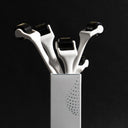From thick and curly to straight and fine, our hair texture is as unique as we are. It's the defining factor that determines the way our hair looks, feels, and behaves.
Understanding your hair texture is essential to unlocking the secrets to healthy, luscious locks that reflect your personality and style.
In this comprehensive guide, we'll delve into the science behind hair texture and how it influences the way we care for and style our hair.
Whether you're blessed with straight, wavy, curly, or coily hair, you'll learn how to embrace your natural hair texture and make it work for you.
So, let's get started and discover the secrets to healthy, beautiful hair that truly reflects who you are!
Table of content
What is hair texture?

Hair texture is an essential factor that determines the circumference of your hair strands. The thickness and diameter of each strand have a significant impact on how your hair looks, feels, and behaves.
There are three different types of hair textures: fine, medium, and thick, each with its own unique traits that distinguish it from the other types and dictate the care and treatment it requires.
- Fine hair is the most fragile hair texture, with thin hair strands that have only two hair layers: cortex and cuticle. Fine hair is challenging to maintain in a particular style and is prone to oiliness. Additionally, using too many hair products can weigh fine hair down, making it susceptible to breakage.
- Medium hair is the most common hair texture, thicker than fine hair, with individual hair strands that have the same two hair layers as fine hair but may also have a third layer called the medulla. Medium hair can hold hairstyles better, looks thicker, and is more resistant to breakage.
- Thick or coarse hair, on the other hand, has all three hair layers: cortex, cuticle, and medulla. Thick hair appears to be fuller, can hold hairstyles well, and is more tolerant to heat, styling products, hair dye, and breakage than fine or medium hair. However, it takes longer to dry, and it's prone to frizz in humid weather.
As your leading source for hair health information over the past 4 years, we never compromise on accuracy. When it comes to your health, you deserve information you can truly rely on - and earning your trust is our top priority.
Here's how Scandinavian Biolabs ensures every piece of content meets the highest standards of accuracy and integrity:
- Credentialed Experts: Our reviewers are actively practicing doctors and medical researchers
- Stringent Reviews: Content undergoes rigorous editing by subject specialists and review by a practicing doctor.
- Evidence-Based: We rely on well-established research from trusted scientific sources like peer-reviewed journals and health authorities.
- Full Transparency: Our editorial standards, writer credentials, reviewer credentials, correction process, and funding are all publicly documented.
- Independent Voice: While we do promote products, we operate in a vacuum to business operations. Our main goal is just an unwavering commitment to providing medically-sound guidance.
You can count on Scandinavian Biolabs to consistently deliver the trustworthy health information you deserve. Read our Editorial Standards.
Different hair types

Hair types can be broadly categorized as straight or curly. But within these two main groups, there are a number of subgroups that determine your hair's texture, thickness, and curl pattern.
Type 1: Straight hair
Straight hair is often fine in texture and can quickly become oily and shiny due to the lack of curls in the hair. There are three subcategories within Type 1 hair:
- Type 1A Hair: This type of hair is ultra-straight and fine, and is commonly found in people of Asian descent.
- Type 1B Hair: This type of hair is thicker than Type 1A Hair, with medium texture and more volume. It's still straight but has more body.
- Type 1C Hair: Type 1C hair is very thick and coarse, but still straight and shiny. It can be hard to style due to its thickness and can be prone to frizz.
Type 2: Wavy hair
Wavy hair has more curls than straight hair but less curls than curly hair. It's usually thicker than Type 1 hair. There are three subcategories within Type 2 hair:
- Type 2A Hair: This type of hair is wavy and can be fine and thin or a little coarser. It normally has s-shaped waves and is easy to style.
- Type 2B Hair: This type of hair is wavy and medium-thick. It can be frizzier than Type 2A hair and is a bit harder to style.
- Type 2C Hair: Type 2C hair is wavy, thick, and coarse. It can get very frizzy and hard to style.
Type 3: Curly hair
Curly hair has clear, springy curls that straighten when wet and return to their curly shape as they dry. There are two subcategories within Type 3 hair:
- Type 3A Hair: This type of hair is shiny and thick with defined curls. It can also get frizzy.
- Type 3B Hair: This type of hair can have a combination of hair textures and has tighter curls than Type 3A hair.
Type 4: Coily/kinky hair
Coily or kinky hair is very curly and often coarse, but can also be sensitive and easily damaged. There are three subcategories within Type 4 hair:
- Type 4A Hair: This type of hair is soft, with tight, well-defined curls.
- Type 4B Hair: This type of hair is soft and fragile, with very tight and less defined curls than Type 4A hair.
- Type 4C Hair: Type 4C hair has very tight curls or kinks, and may not even look curly. It can be the most fragile and prone to breakage.
Read this: 15 Easy & Effective Ways How To Stop Hair Breakage At Home
Caring for different hair textures
Understanding your hair texture is essential to choosing the right products for your hair. Using the wrong products can lead to dryness, damage, and breakage.
One effective hair care solution for all hair types is the Scandinavian Biolabs Hair Growth Routine. This 3-Step Hair Growth Routine has been developed by experts to help reduce hair thinning, support the growth of new hair, and help maintain strong and vital hair.

Each product contains multiple plant growth factors that have been developed through stem cell technology to help nurture hair follicles and encourage hair growth.
Other hair care tips for different hair textures include:
- Using a moisturizing shampoo and conditioner
- Avoiding over-washing hair
- Using a deep conditioner regularly
- Avoiding over-brushing or over-manipulating hair
- Using a wide-tooth comb to detangle hair
- Avoiding hot styling tools as much as possible
- Using a heat protectant when using hot styling tools
Styling tips for different hair textures
Styling your hair according to its texture is essential to achieving a healthy and beautiful look. For different hair types to look their best, you need to use different styling techniques and products. Here are some popular styling options for each hair texture type:
Straight hair
Straight hair is the easiest to style and can be worn straight, curled, or in a variety of updos. However, it can sometimes lack volume and texture.
To add volume to straight hair, use a volumizing mousse or dry shampoo before styling. Additionally, you can add texture to straight hair by using a sea salt spray or texture spray.
Wavy hair
Wavy hair can be styled in loose, beachy waves or more defined curls. To make your waves look better, use a mousse or cream that makes curls and diffuses your hair as you blow-dry it. Scrunching your hair while it air dries can also help define waves and prevent frizz.
Curly hair
Curly hair can be styled in various ways, from tight ringlets to loose waves. To enhance your curls, use a curl-defining cream and scrunch your hair while blow-drying or air-drying. Using a diffuser while blow-drying can also help to define curls and reduce frizz.
Read this: The Curly Girl Method UK: The Foolproof Guide To Perfect Curls
Coily hair
Coily hair can be styled in various ways, from tight coils to looser curls. To enhance your coils, use a curl-defining cream or butter and twist your hair while it's damp.
Allow your hair to air-dry or use a diffuser when blow-drying. Additionally, protective styles such as braids or twists can help to protect coily hair and promote healthy growth.
Regardless of hair texture, it's essential to protect your hair while styling. Avoid tight hairstyles that pull on your hair; use a silk or satin pillowcase to reduce friction; and always use a heat protectant when using hot styling tools.
In addition, incorporating a hair mask or deep conditioner into your hair care routine can help nourish and hydrate your hair, making it more manageable and easier to style.
By using the right styling techniques and products for your hair texture, you can achieve beautiful, healthy hair that you'll love to show off!
Conclusion
Understanding your hair texture is essential to maintaining healthy and beautiful hair. Hair texture is determined by several factors, including genetics, ethnicity, and gender.
If you know what kind of hair you have, you can use the right products and styling methods to take care of and style it well.
The Scandinavian Biolabs Hair Growth Routine is a highly effective solution for all hair types, as it contains multiple plant growth factors that have been developed through stem cell technology, to help nurture hair follicles and encourage hair growth.
By following the care and styling tips provided in this guide, you can embrace your natural hair texture and achieve the beautiful, healthy hair you deserve.
References:
- https://medlineplus.gov/genetics/understanding/traits/hairtexture/
- https://www.researchgate.net/publication/333163521_How_Blood_Group_Influence_Hair_Texture
- https://www.sciencedirect.com/topics/medicine-and-dentistry/hair-texture
Read more:






